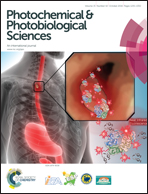Temperature-boosted photocatalytic H2 production and charge transfer kinetics on TiO2 under UV and visible light†
Abstract
This study investigates the effect of reaction temperature (298–353 K) on photocatalytic H2 production in bare and platinized TiO2 (Pt/TiO2) suspensions containing various organic hole scavengers (EDTA, methanol, and formic acid) under UV (λ > 320 nm) and visible light (λ > 420 nm for ligand-to-metal charge transfer). H2 production rates are enhanced ∼7.8- and ∼2.5-fold in TiO2 and Pt/TiO2 suspensions, respectively, with EDTA under UV by simply elevating the reaction temperature from 298 K to 323 K (ΔT = 25 °C). Such a temperature-boosted increase in H2 production is always observed, regardless of the TiO2 crystalline structure (anatase, rutile, and an anatase/rutile mixture), type of hole scavenger, and irradiation wavelength range. It is estimated that approximately 90% of incident photons are utilized in H2 production, for which the activation energy is 25.5 kJ mol−1. Detailed photoelectrochemical analyses show the positive relationship between reaction temperature and photocurrent generation, with charge carrier mobility and interfacial charge transfer improving at higher temperatures. Other possible factors, such as H2 solubility and mass transport, play a limited role.


 Please wait while we load your content...
Please wait while we load your content...